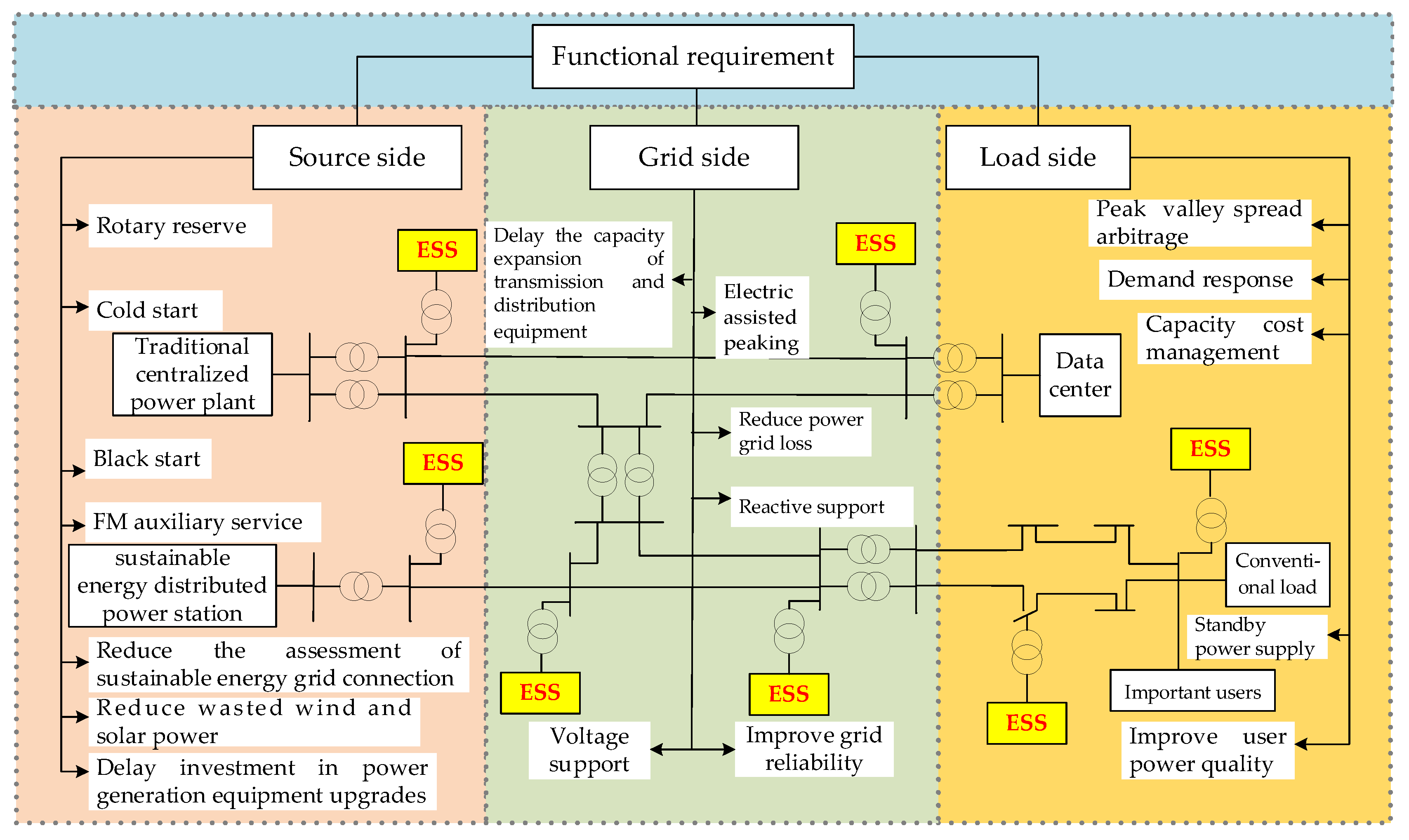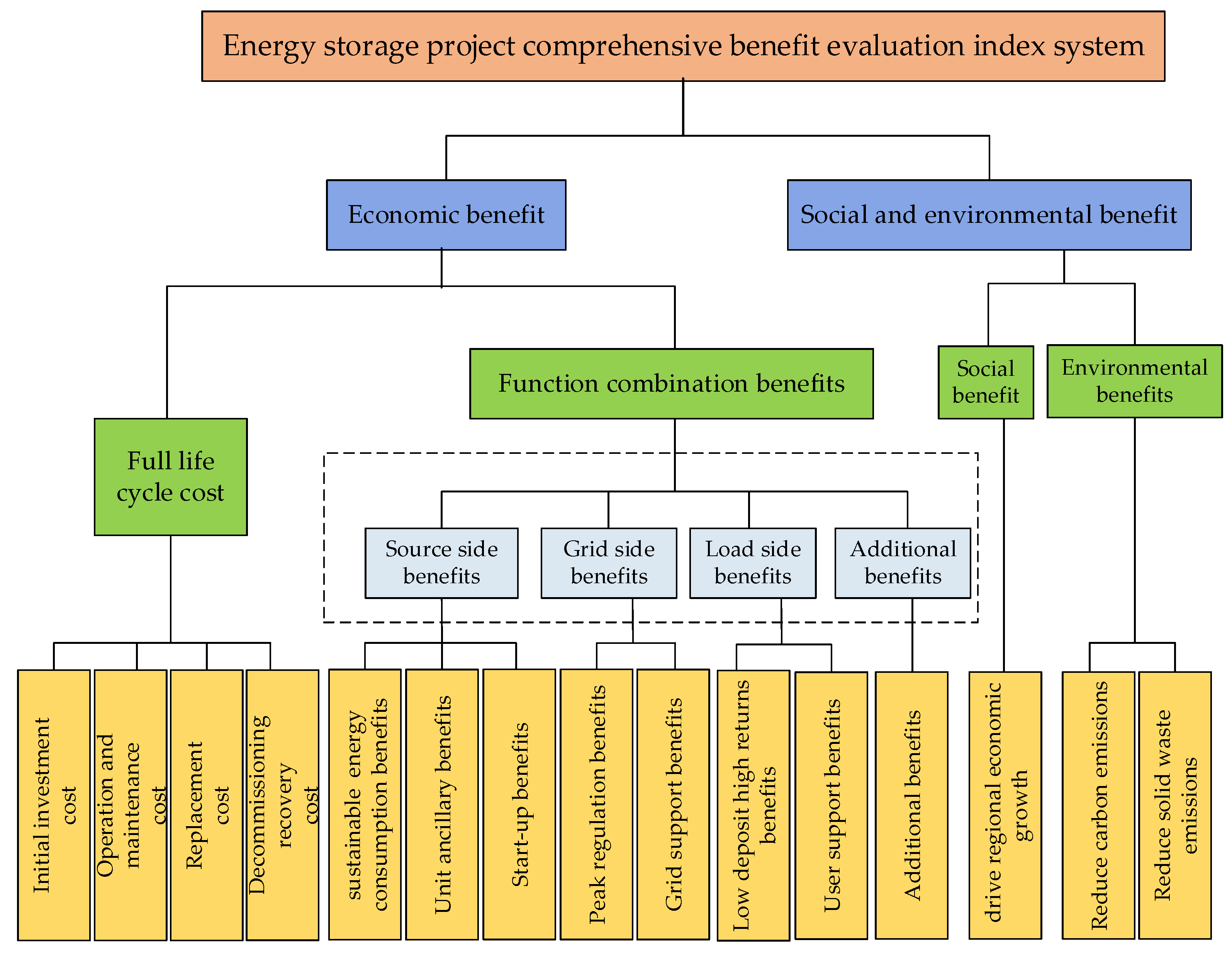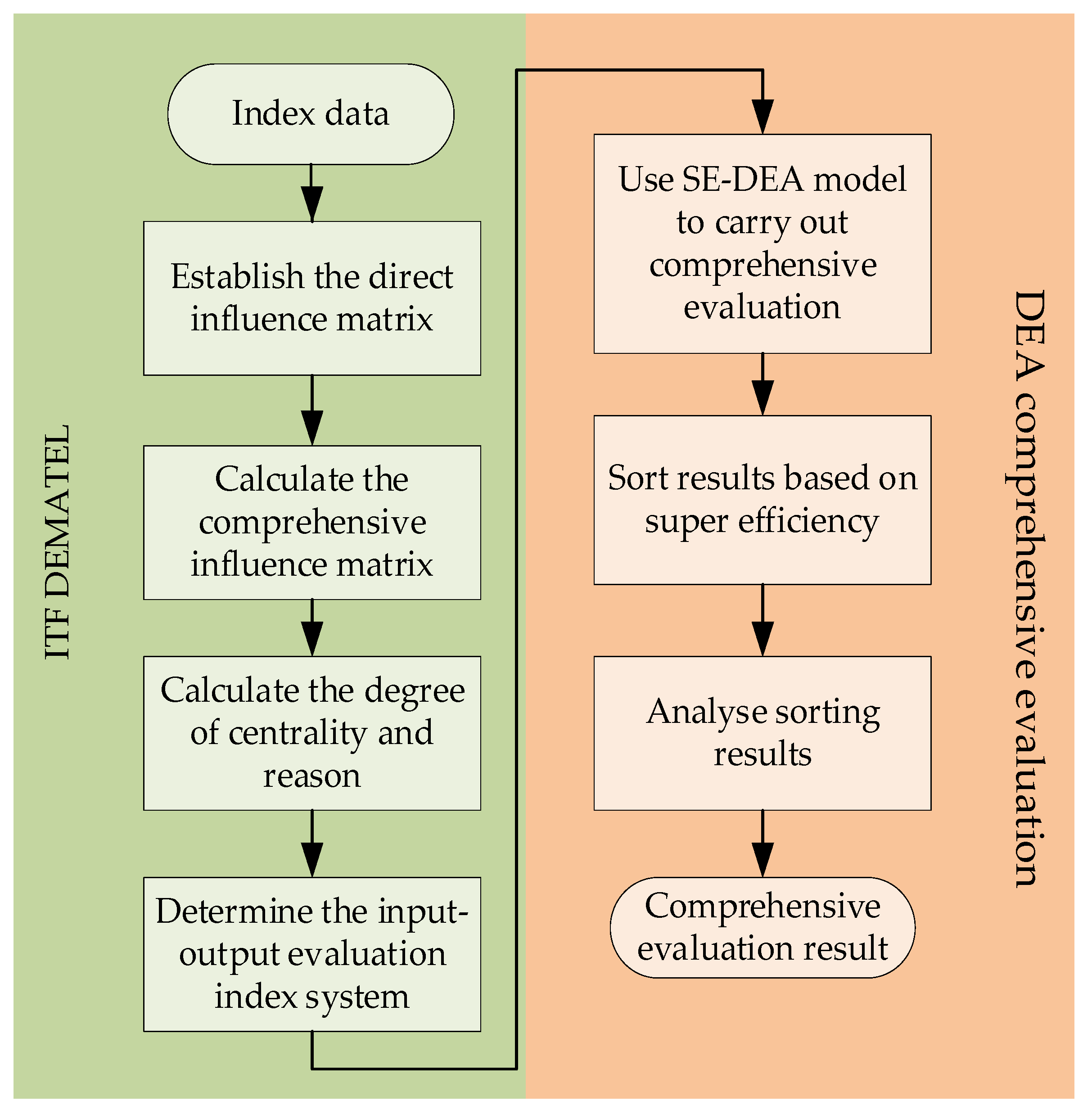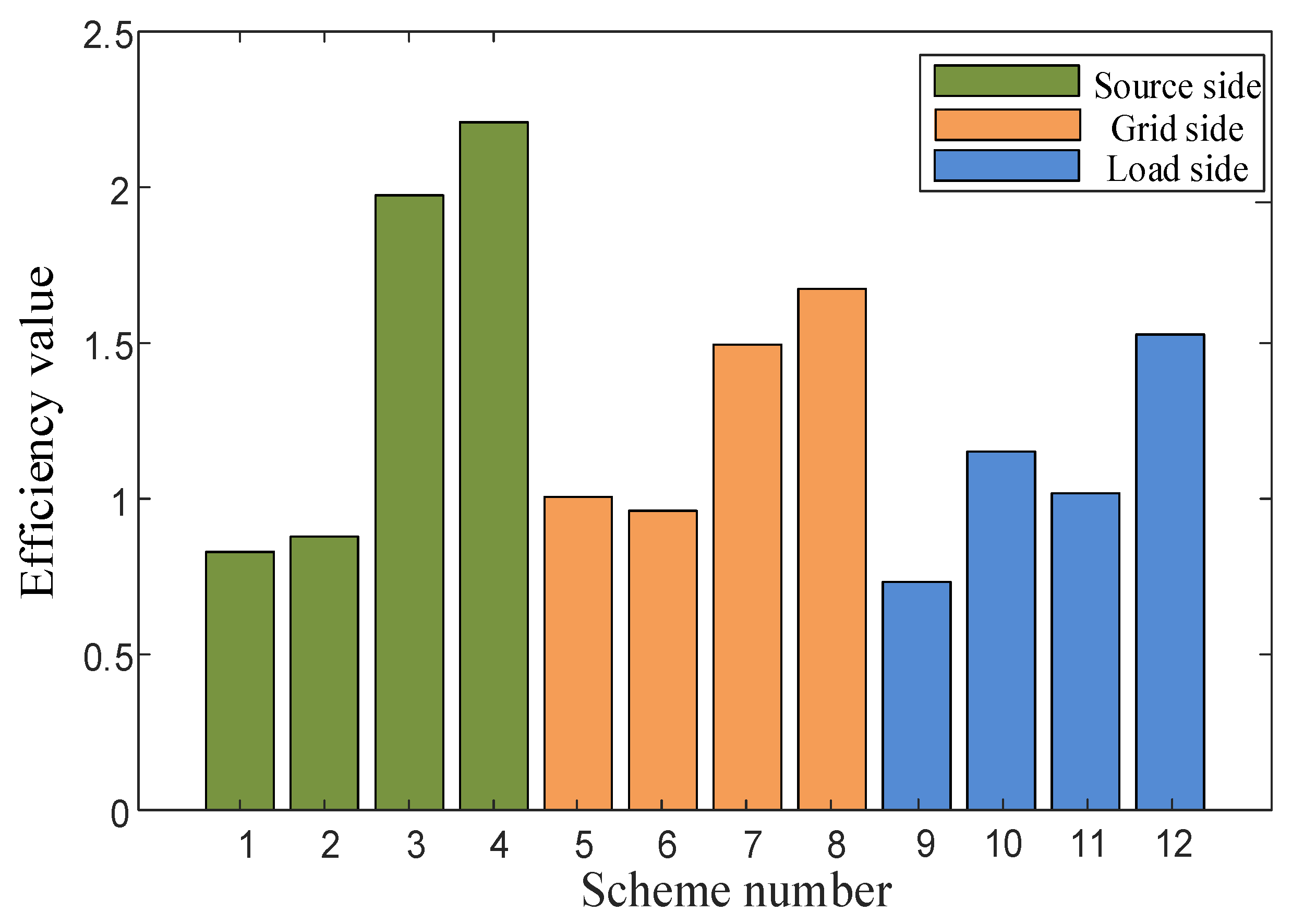Functional-Combination-Based Comprehensive Benefit Evaluation of Energy Storage Projects under Source-Grid-Load Scenarios via Super-Efficiency DEA
Abstract
1. Introduction
- (1)
- Various functional characteristics of source-grid-load sides are analyzed and eight functional combination schemes are formed. Based on the profit coefficient method and equivalent cost method, the functional combination benefit index is established, which is combined with the whole life cycle cost and social and environmental benefits to form the comprehensive benefit evaluation index system of ESPs.
- (2)
- ITFN is combined with the traditional DEMATEL method to analyze the correlation and causality among the indices, and an input–output evaluation index system based on the analysis results of the indicators is built.
- (3)
- A comprehensive evaluation method based on fuzzy DEMATEL and SE-DEA is proposed. The rationality and effectiveness of the proposed method are verified through examples, which can provide reference for improving the operational planning of ESPs.
2. Functional Combination Analysis of Energy Storage
2.1. Functional Analysis
2.1.1. Source Side
- (1)
- Reduce sustainable energy grid-connected assessment: sustainable energy grid-connected consumption has an impact on the stable operation of the system, and an ESS can assist grid-connected function [16].
- (2)
- (3)
- Black start: after the failure or power outage of the power system, the power system can be restarted by using the ESS as the backup power supply [19].
- (4)
- Cold start: an ESS can quickly release energy during cold start by storing a large amount of electrical energy, providing the high power output required for start-up [20].
- (5)
- Rotary backup: when an ESS is used as rotary backup, it can provide the rapid adjustment ability and stability support of the power system in the short term [21].
- (6)
- Delaying power generation equipment upgrade investment: through the adjustment capacity of an ESS and the absorption of sustainable energy, the additional load demand can be met, the frequency and voltage support can be involved, and the demand for new power generation equipment and upgrade investment can be delayed [1].
- (7)
- Frequency control and ancillary service: the response speed of an ESS for frequency modulation auxiliary service is high, which can be used as a frequency modulation resource [22].
2.1.2. Grid Side
- (1)
- Power auxiliary peak regulation: an ESS can absorb electric energy in the off-peak period of power load and release electric energy in the peak period of power load to alleviate the contradiction between unbalanced power supply and demand caused by the large difference between peak and valley [23].
- (2)
- Improve the reliability of the power grid: the ESS enhances the stability and reliability of the power grid by providing backup capacity and rapid adjustment ability [24].
- (3)
- Delay the capacity expansion of transmission and distribution equipment: the power load is less than or close to the rated load during most of the year, and energy storage is used to deal with the insufficient capacity of the grid during peak hours, so as to alleviate the investment pressure of expansion construction [25].
- (4)
- Reactive power support: when the reactive power in the power system is unbalanced, the ESS realizes reactive power compensation adjustment to the power grid by rapidly adjusting reactive power output [26].
- (5)
- Voltage support: by installing an ESS on the transmission and distribution lines, reactive power can be absorbed or injected to adjust the transmission voltage and maintain the stable operation of the transmission and distribution lines [27].
- (6)
- Reduce network loss: the ESS is used as the load to store electric energy during the valley, and as the power source to release electric energy during the peak, so as to reduce the current on the line during the peak load and reduce the network loss [28].
2.1.3. Load Side
- (1)
- Peak–valley spread arbitrage: in a period of low electricity price, electricity is purchased and stored by an ESS. In the peak period, the stored electricity is used and the price difference is used to obtain income [29].
- (2)
- Capacity cost management: an ESS is used to store electric energy during the valley period of power consumption, and discharge it during the peak period of power consumption, which can replace part of the power supply of the power grid, thereby reducing the cost of capacity management [29].
- (3)
- Improve user power quality: an ESS can reduce problems such as voltage rise and frequency fluctuation to reduce the loss caused by power quality events [30].
- (4)
- Demand response: the ESS responds to market price signals, incentive mechanisms, or instructions issued by operators to change its short- or long-term operation strategies [31].
- (5)
- Backup power supply: for some clients with high requirements for reliability, an ESS can provide continuous power supply in the event of power failure or failure [29].
2.1.4. Source-Grid-Load System
2.2. Functional Combination Schemes
3. Establishment of Comprehensive Evaluation Index System
4. Fuzzy DEMATEL and the SE-DEA Model
4.1. Intuitive Trapezoidal Fuzzy Number
4.2. Fuzzy DEMATEL Method
4.3. Comprehensive Evaluation Process Based on the SE-DEA Method
5. Case Study
5.1. Example Setting
5.2. Result Analysis
5.3. Comparative Analysis of Different Evaluation Methods
6. Conclusions
- (1)
- The SE-DEA method based on ITF DEMATEL can flexibly describe the fuzziness of expert opinions and analyze the input–output relationship among indicators. Compared with conventional evaluation methods, the method proposed in this paper has certain advantages.
- (2)
- The functional combination can be leveraged to the fullest extent of the functionality of existing energy storage equipment and improve the efficiency of ESPs. This study can provide reference for the future operation planning of energy storage equipment. The results indicate that the multifunctional combination configuration scheme on the source side has the highest comprehensive benefit evaluation, with an efficiency value of 2.209.
Author Contributions
Funding
Institutional Review Board Statement
Informed Consent Statement
Data Availability Statement
Conflicts of Interest
Appendix A
| Index | Influence Degree p | Affected Degree q | Centrality Degree m | Causality Degree n |
|---|---|---|---|---|
| R1 | 5.7137 | 0.7821 | 6.4958 | 4.9316 |
| R2 | 4.2351 | 1.2213 | 5.4564 | 3.0138 |
| R3 | 2.4256 | 1.2333 | 3.6589 | 1.1923 |
| R4 | 1.9255 | 1.0253 | 2.9508 | 0.9002 |
| R5 | 0.8561 | 4.7862 | 5.6423 | −3.9301 |
| R6 | 1.8544 | 4.2221 | 6.0765 | −2.3677 |
| R7 | 0.5644 | 0.9421 | 1.5065 | −0.3777 |
| R8 | 1.2546 | 4.8752 | 6.1298 | −3.6206 |
| R9 | 2.1251 | 5.2156 | 7.3407 | −3.0905 |
| R10 | 1.9542 | 4.2687 | 6.2229 | −2.3145 |
| R11 | 1.0121 | 3.2102 | 4.2223 | −2.1981 |
| R12 | 0.8292 | 1.5225 | 2.3517 | −0.6933 |
| R13 | 2.5214 | 2.8273 | 5.3487 | −0.3059 |
| R14 | 1.7324 | 2.5243 | 4.2567 | −0.7919 |
| R15 | 1.6891 | 2.5225 | 4.2116 | −0.8334 |
| Parameter | Unit | Value |
|---|---|---|
| Power cost coefficient | ¥/kW | 1500 |
| Capacity cost coefficient | ¥/kWh | 3000 |
| Operation and maintenance cost coefficient | ¥/kW | 0.05 |
| SOC range | % | 20–80 |
| Overall performance | Annual decay rate | 0.4% |
| Personnel expenses | 10,000 ¥/year | 6 |
| Carbon emission reduction coefficient | ton/a Ton of coal | 0.716 |
| Carbon content | % | 90 |
| Coal conversion coefficient | % | 92 |
| Solid waste emission reduction coefficient | Kg/a Ton of coal | 30 |
| Other expenses | ¥10,000 | 56 |
| Return and disposal | 10,000 ¥/MWh | 20 |
| Battery life | year | 10 |
| Scenarios | Scheme Number | Main Functions | Rated Power/kw | Rated Capacity/kwh |
|---|---|---|---|---|
| Source side | 1 | functional combination ① | 465 | 1455 |
| 2 | functional combination ② | 357 | 1267 | |
| 3 | functional combination ③ | 237 | 643 | |
| 4 | functional combinations ①, ②, ③ | 859 | 2674 | |
| Grid side | 5 | functional combination ④ | 469 | 1373 |
| 6 | functional combination ⑤ | 285 | 1008 | |
| 7 | functional combination ⑧ | 184 | 519 | |
| 8 | functional combinations ④, ⑤, ⑧ | 694 | 2238 | |
| Load side | 9 | functional combination ⑥ | 655 | 2014 |
| 10 | functional combination ⑦ | 276 | 788 | |
| 11 | functional combination ⑧ | 177 | 483 | |
| 12 | functional combinations ⑥, ⑦, ⑧ | 1045 | 2823 |
| Scheme | /¥10,000 | /¥10,000 | /¥10,000 | /¥10,000 |
|---|---|---|---|---|
| 1 | 868.8 | 13.9 | 8.26 | 81.5 |
| 2 | 675.19 | 10.79 | 6.31 | 67.5 |
| 3 | 385.16 | 7.36 | 3.15 | 38.16 |
| 4 | 1605.52 | 25.62 | 15.8 | 89.2 |
| 5 | 461.75 | 47.85 | 4.52 | 42.35 |
| 6 | 372.23 | 33.35 | 3.56 | 35.52 |
| 7 | 190.62 | 20.7 | 1.91 | 18.6 |
| 8 | 787.02 | 82.5 | 7.86 | 76.3 |
| 9 | 702.45 | 32.75 | 6.98 | 70.03 |
| 10 | 277.8 | 13.8 | 2.71 | 27.67 |
| 11 | 171.45 | 8.85 | 1.67 | 17.15 |
| 12 | 1003.65 | 52.25 | 10.02 | 91.2 |
| Scheme | /% | /Tons | /Tons | ||||||||
|---|---|---|---|---|---|---|---|---|---|---|---|
| 1 | 31.2 | 12.5 | 3.6 | 1e−4 | 1e−4 | 1e−4 | 1e−4 | 10.1 | 6.1 | 7.9 | 2.7 |
| 2 | 23.6 | 11.9 | 3.5 | 1e−4 | 1e−4 | 1e−4 | 1e−4 | 9.6 | 6.4 | 7.6 | 2.2 |
| 3 | 16.5 | 10.8 | 3.2 | 1e−4 | 1e−4 | 1e−4 | 1e−4 | 10.2 | 6.5 | 7.7 | 2.5 |
| 4 | 85.2 | 26.8 | 3.8 | 1e−4 | 1e−4 | 1e−4 | 1e−4 | 11.2 | 6.9 | 8.2 | 2.8 |
| 5 | 1e−4 | 1e−4 | 1e−4 | 30.9 | 43.2 | 1e−4 | 1e−4 | 9.8 | 5.3 | 7.3 | 2.2 |
| 6 | 1e−4 | 1e−4 | 1e−4 | 20.2 | 26.7 | 1e−4 | 1e−4 | 9.5 | 5.7 | 7.4 | 2.1 |
| 7 | 1e−4 | 1e−4 | 1e−4 | 12.7 | 14.3 | 1e−4 | 1e−4 | 6.2 | 3.1 | 5.2 | 2.2 |
| 8 | 1e−4 | 1e−4 | 1e−4 | 85.3 | 92.6 | 1e−4 | 1e−4 | 19.9 | 20.2 | 19.8 | 4.2 |
| 9 | 1e−4 | 1e−4 | 1e−4 | 1e−4 | 1e−4 | 37.1 | 30.6 | 9.1 | 4.5 | 6.9 | 2.5 |
| 10 | 1e−4 | 1e−4 | 1e−4 | 1e−4 | 1e−4 | 22.5 | 16.9 | 5.2 | 2.6 | 4 | 3.5 |
| 11 | 1e−4 | 1e−4 | 1e−4 | 1e−4 | 1e−4 | 9.1 | 6.2 | 3.9 | 1.8 | 2.5 | 2.11 |
| 12 | 1e−4 | 1e−4 | 1e−4 | 1e−4 | 1e−4 | 92.9 | 85.1 | 12.5 | 8.1 | 9.6 | 4.12 |
| Scheme | ITFN DEA | ITF SE-DEA | SE-DEA | Triangular Fuzzy SE-DEA | Entropy-Based TOPSIS | ||||
|---|---|---|---|---|---|---|---|---|---|
| Efficiency | No. | Efficiency | No. | Efficiency | No. | Closeness | No. | ||
| 1 | 0.8296 | 0.8296 | 11 | 1.0658 | 8 | 0.7274 | 10 | 0.3007 | 10 |
| 2 | 0.8784 | 0.8784 | 10 | 0.8760 | 12 | 0.6851 | 11 | 0.3025 | 9 |
| 3 | 1 | 1.9738 | 2 | 1.1890 | 4 | 2.2738 | 2 | 0.4456 | 3 |
| 4 | 1 | 2.209 | 1 | 2.1171 | 1 | 2.9591 | 1 | 0.4896 | 2 |
| 5 | 1 | 1.0058 | 8 | 1.0549 | 9 | 1.0555 | 8 | 0.3537 | 6 |
| 6 | 0.9609 | 0.9609 | 9 | 1.1264 | 7 | 0.8432 | 9 | 0.3284 | 8 |
| 7 | 1 | 1.4946 | 5 | 1.6161 | 3 | 1.3741 | 4 | 0.4416 | 4 |
| 8 | 1 | 1.6738 | 3 | 2.0596 | 2 | 1.2532 | 5 | 0.4993 | 1 |
| 9 | 0.7329 | 0.7329 | 12 | 0.9808 | 11 | 0.6384 | 12 | 0.2663 | 12 |
| 10 | 1 | 1.1512 | 6 | 1.1896 | 5 | 1.1825 | 6 | 0.4212 | 5 |
| 11 | 1 | 1.0177 | 7 | 1.0459 | 10 | 1.0859 | 7 | 0.3527 | 7 |
| 12 | 1 | 1.5277 | 4 | 1.1853 | 6 | 1.9245 | 3 | 0.2831 | 11 |
References
- Li, J.; Jiang, Y.; Ma, S.; Cui, Y.; Guo, X. Application scenario and optimal configuration of distributed energy storage in new power system. High Volt. Technol. 2024, 50, 30–41. [Google Scholar] [CrossRef]
- China Electricity Council. New Energy Distribution and Energy Storage Operation Research Report; China Electricity Council: Beijiing, China, 2022; Available online: https://cec.org.cn/detail/index.html?3-315493 (accessed on 14 November 2022).
- China Electricity Council. Industry Statistics of Electrochemical Energy Storage Power Station in the First Half of 2023; China Electricity Council: Beijiing, China, 2023; Available online: https://cec.org.cn (accessed on 10 November 2023).
- Xiong, X.; Yang, R.; Ye, L.; Li, J. Economic evaluation of large-scale energy storage system on power demand side. Trans. China Electrotech. Soc. 2013, 28, 224–230. [Google Scholar] [CrossRef]
- Lou, S.; Yi, L.; Wu, Y.; Hou, T.; Yang, Y. Battery energy storage capacity optimization based on variable life model. Trans. China Electrotech. Soc. 2015, 30, 265–271. [Google Scholar] [CrossRef]
- Nejad, B.M.; Vahedi, M.; Hoseina, M. Economic model for coordinating large-scale energy storage power plant with demand response management options in smart grid energy management. IEEE Access 2023, 11, 16483–16492. [Google Scholar] [CrossRef]
- Zhao, M.; Zhao, H.; Huo, H. Comprehensive evaluation of user energy storage system configuration schemes based on the improved triangular fuzzy VIKOR method. Electr. Power 2022, 55, 185–191. [Google Scholar]
- Yi, C.; Qi, Q.; Long, Z. New energy storage technology of the Chinese patent layout analysis. Energy Storage Sci. Technol. 2024, 1–10. [Google Scholar] [CrossRef]
- Bie, Z.; Li, G.; Xie, H. Microgrid reliability assessment considering load and energy storage coordination optimization. Trans. China Electrotech. Soc. 2014, 29, 64–73. [Google Scholar] [CrossRef]
- Qi, F.; Wei, G.; Sun, J. Equipment in-service assessment based on intuitionistic trapezoidal fuzzy TOPSIS. Ordnance Ind. Autom. 2023, 42, 1–5+10. [Google Scholar] [CrossRef]
- Lei, Q.; Miao, S.; Guo, B.; Sun, Q.; Ye, C. Comprehensive evaluation of layered energy storage system based on hierarchical analysis and improved approach to ideal solution. Power Syst. Prot. Control. 2017, 45, 13–19. [Google Scholar]
- Goto, M.; Tomikawa, T.; Sueyoshi, T. Efficiency and Mergers and Acquisitions of Electric Utility Companies. Energies 2024, 17, 1972. [Google Scholar] [CrossRef]
- Hmamed, H.; Benghabrit, A.; Cherrafi, A. Achieving a sustainable transportation system via economic, environmental, and social optimization: A comprehensive AHP-DEA approach from the waste transportation sector. Sustainability 2023, 15, 15372. [Google Scholar] [CrossRef]
- Ishida, R.; Goto, M. Integrated efficiency of Japan’s 47 prefectures incorporating sustainability factors. Energies 2024, 17, 1910. [Google Scholar] [CrossRef]
- Peng, L.; Miao, W.; Cun, D. Comprehensive benefit evaluation method of renewable energy power generation technology based on fuzzy Dematel-Superefficiency DEA. Power Grid Technol. 2023, 1–12. [Google Scholar] [CrossRef]
- Li, S.; Ma, Y.; Zhang, C.; Yu, J. Static voltage stability prediction for PCCs of new energy power stations in the grid-connected system. J. Phys. Conf. Ser. 2022, 2369, 012037. [Google Scholar] [CrossRef]
- Zhao, J.; Su, J.; Pan, F.; Yang, Y.; Chen, M.; Zhang, Y. Dual-objective optimization planning of distributed energy storage in active distribution network considering photovoltaic fluctuations. Renew. Energy 2022, 40, 1546–1553. [Google Scholar] [CrossRef]
- Zhang, W.; Li, Z.; Chen, D.; Li, Y.; Di, W. Random optimal configuration and location method of distributed energy storage system on distribution network side. High Volt. Electr. Appar. 2023, 59, 125–135. [Google Scholar] [CrossRef]
- Heidari-Akhijahani, A.; Butler-Purry, K.L. A review on black-start service restoration of active distribution systems and microgrids. Energies 2024, 17, 100. [Google Scholar] [CrossRef]
- Lin, X.; Wang, W.; Zhao, J.; Li, Y. Temporally and distributionally robust optimization for cold-start recommendation. Proc. AAAI Conf. Artif. Intell. 2024, 38, 8750–8758. [Google Scholar] [CrossRef]
- Zhu, Z.; Wang, X.; Wu, X. Operation Strategy for composite energy storage participating in electric energy and ancillary service markets. Autom. Electr. Power Syst. 2023, 18, 80–90. [Google Scholar] [CrossRef]
- Guo, Y.; Li, A.; Sun, W. Frequency regulation bidding strategy of energy storage power station considering price prediction. Proc. CSEE 2024, 1–12. [Google Scholar] [CrossRef]
- Guan, Y.; Zhang, C.; Zhang, Z. Virtual power plant planning considering multi-dimensional generation-load correlation and peak shaving ability. Power Syst. Technol. 2024, 1–13. [Google Scholar] [CrossRef]
- Zhang, S.; Li, Y.; Liu, W. Economic, low-carbon and reliable multi-objective optimal configuration method of cloud energy storage for microgrid clusters. Autom. Electr. Power Syst. 2024, 48, 21–30. [Google Scholar] [CrossRef]
- Deng, S.; Liu, W.; Liu, C.; Liu, Q.; Li, S.; Liu, Z. Energy storage planning and decision-making method of distribution network considering double uncertainty and comprehensive efficiency. Energy Storage Sci. Technol. 2022, 11, 164–175. [Google Scholar] [CrossRef]
- Ruihuan, R. Research on optimal distribution of distributed energy storage in intelligent distribution network. Electr. Appl. 2021, 40, 31–35. (In Chinese) [Google Scholar]
- Wang, T.; Miao, S.; Yao, F. Multi-level energy storage collaborative optimization operation strategy for power systems considering frequency and voltage stability constraints. Trans. China Electrotech. Soc. 2024, 1–18. [Google Scholar] [CrossRef]
- Zhuang, Z.; Kong, Y.; Yang, S. Multi-objective optimization operation of distribution network virtual power plant based on AUGMECON2. Power Demand Side Manag. 2024, 26, 42–47. [Google Scholar] [CrossRef]
- Sun, B.; Zhang, Z.; Hu, J.; Meng, Z.; Huang, B.; Li, N. An energy storage capacity configuration method for a provincial power system considering flexible adjustment of the tie-line. Energies 2024, 17, 270. [Google Scholar] [CrossRef]
- Li, J.; Tan, Y.; Wang, H.; Huang, J. Optimization strategy of energy storage system configuration in distribution network and optical storage micro-network. High Volt. Technol. 2022, 48, 1893–1902. [Google Scholar] [CrossRef]
- Pan, T.; Xu, Y.; Wang, Y.; Cai, R.; Zeng, M. Integrated energy system scheduling optimization considering generalized integrated demand response. Mod. Power 2023, 1–10. [Google Scholar] [CrossRef]
- Yao, Y.; Wu, H.; Lin, D.; Wang, X. Multi-dimensional value evaluation and application of energy storage system in distribution network. Zhejiang Electr. Power 2022, 41, 36–45. [Google Scholar] [CrossRef]
- Xie, Y.; Li, Y.; Liu, Y.; Du, E.; Xu, Q.; Zhang, N. A preliminary study on a carbon-reducing user-side cloud energy storage model: Operation model and benefit analysis. Proc. CSEE 2023, 1–13. [Google Scholar] [CrossRef]
- Wu, Y.; Liu, Y.; Xu, L.; Li, J.; Hu, K. Energy trading model for community PV users based on multiple games with energy storage assistance. Electr. Power Constr. 2024, 1–14. (In Chinese) [Google Scholar]
- Xu, Z.; Zhang, H.; Zhang, W. Study on the whole life cycle cost of transmission line engineering with carbon price: An analysis from the perspective of new power system. Price Theory Pract. 2023, 166–169. [Google Scholar] [CrossRef]
- Li, C.; Wang, Y.; Li, J.; Zhang, Z.; Huang, J.; Cheng, P. Analysis of photovoltaic black-start energy storage configuration considering feasibility assessment. China South. Power Grid Technol. 2023, 17, 104–112. [Google Scholar] [CrossRef]
- Xiang, Q.; Cao, H. Forecast Analysis of probability distribution of China’s GDP growth rate based on quantile factor models. J. Cent. Univ. Financ. Econ. 2024, 04, 92–103. [Google Scholar] [CrossRef]
- Li, H.; Li, X.; Chen, S.; Li, S.; Kang, Y.; Ma, X. Low-carbon optimal scheduling of integrated energy system considering multiple uncertainties and electricity–heat integrated demand response. Energies 2024, 17, 245. [Google Scholar] [CrossRef]
- Zhao, Y.; Ding, Z.; Yang, C.; Cheng, Q.; Liu, Z. Reliability Allocation of Intuitive Trapezoidal Fuzzy Number and Entropy Weight-TOPSIS. Modul. Mach. Tool Autom. Process. Technol. 2022, 76–80+84. [Google Scholar] [CrossRef]
- Wu, Y.; Liao, M.; Hu, M.; Lin, J.; Zhou, J.; Zhang, B.; Xu, C. A decision framework of low-speed wind farm projects in hilly areas based on DEMATEL-entropy-TODIM method from the sustainability perspective: A case in China. Energy 2019, 213, 119014. [Google Scholar] [CrossRef]
- Zhang, T. Research on optimization and optimal configuration model of hybrid energy storage scheme for new power system. North China Electr. Power Univ. (Beijing) 2022. [Google Scholar] [CrossRef]
- Song, T.; Ye, Z.; Yao, Z. Optimal investment strategy of power grid enterprise technology transformation based on weighted DEA model. Microcomput. Appl. 2021, 37, 161–162+172. (In Chinese) [Google Scholar]
- Xiao, Y.; Xu, J. Risk assessment of battery safety operation of energy storage power station based on combination weighting and TOPSIS. Energy Storage Sci. Technol. 2022, 11, 2574–2584. [Google Scholar] [CrossRef]





| Scenes | Functional Combination Name | The Function Performed by the Combination |
|---|---|---|
| Source side | ① Sustainable energy consumption benefits | ① Reduce sustainable energy grid connection assessment; ② Reduce wasted wind and solar power. |
| ② Unit ancillary benefits | ① Rotary backup; ② Frequency control and ancillary service; ③ Delay investment in power generation equipment upgrades. | |
| ③ Start-up benefits | ① Black start; ② Cold start. | |
| Grid Side | ④ Peak regulation benefits | ① Power auxiliary peak load; ② Reduce network loss; ③ Delay the capacity expansion of transmission and distribution equipment. |
| ⑤ Grid support benefits | ① Reactive support; ② Voltage support; ③ Improve grid reliability. | |
| Load side | ⑥ Low storage high discharge benefits | ① Peak–valley spread arbitrage; ② Capacity cost management; ③ Demand response. |
| ⑦ User support benefits | ① Standby power supply; ② Improve the power quality of users. | |
| All sides | ⑧ Additional benefits | ① Government subsidies; ② Reduce carbon emissions; ③ Coal-saving benefits. |
| Language Variables | ITFN |
|---|---|
| Extremely low | |
| Low | |
| Medium | |
| High | |
| Extremely high |
Disclaimer/Publisher’s Note: The statements, opinions and data contained in all publications are solely those of the individual author(s) and contributor(s) and not of MDPI and/or the editor(s). MDPI and/or the editor(s) disclaim responsibility for any injury to people or property resulting from any ideas, methods, instructions or products referred to in the content. |
© 2024 by the authors. Licensee MDPI, Basel, Switzerland. This article is an open access article distributed under the terms and conditions of the Creative Commons Attribution (CC BY) license (https://creativecommons.org/licenses/by/4.0/).
Share and Cite
Qu, H.; Ye, Z. Functional-Combination-Based Comprehensive Benefit Evaluation of Energy Storage Projects under Source-Grid-Load Scenarios via Super-Efficiency DEA. Sustainability 2024, 16, 4278. https://doi.org/10.3390/su16104278
Qu H, Ye Z. Functional-Combination-Based Comprehensive Benefit Evaluation of Energy Storage Projects under Source-Grid-Load Scenarios via Super-Efficiency DEA. Sustainability. 2024; 16(10):4278. https://doi.org/10.3390/su16104278
Chicago/Turabian StyleQu, Hong, and Ze Ye. 2024. "Functional-Combination-Based Comprehensive Benefit Evaluation of Energy Storage Projects under Source-Grid-Load Scenarios via Super-Efficiency DEA" Sustainability 16, no. 10: 4278. https://doi.org/10.3390/su16104278
APA StyleQu, H., & Ye, Z. (2024). Functional-Combination-Based Comprehensive Benefit Evaluation of Energy Storage Projects under Source-Grid-Load Scenarios via Super-Efficiency DEA. Sustainability, 16(10), 4278. https://doi.org/10.3390/su16104278





